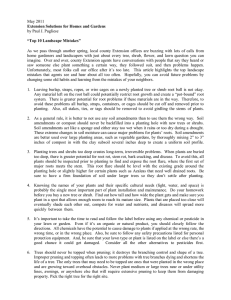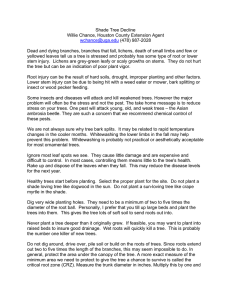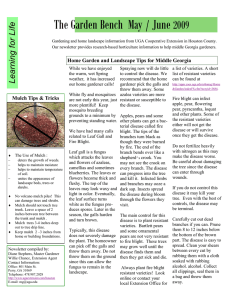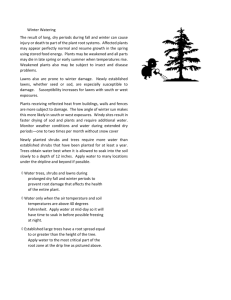EXTENSION SOLUTIONS FOR HOMES & GARDENS
advertisement
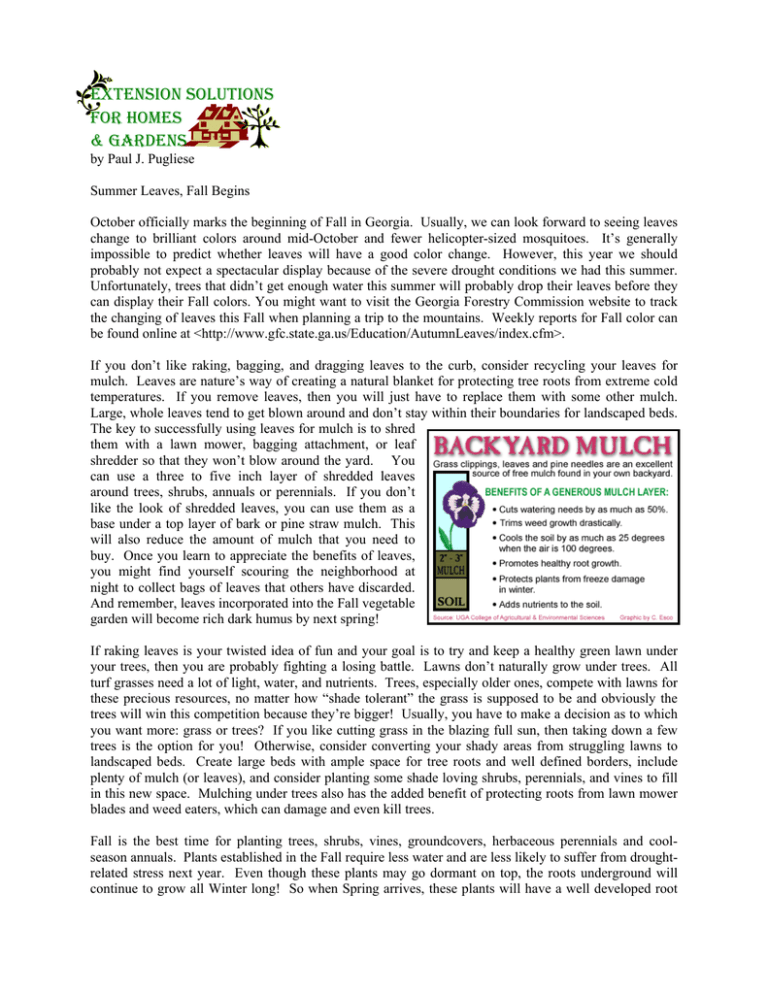
EXTENSION SOLUTIONS FOR HOMES & GARDENS by Paul J. Pugliese Summer Leaves, Fall Begins October officially marks the beginning of Fall in Georgia. Usually, we can look forward to seeing leaves change to brilliant colors around mid-October and fewer helicopter-sized mosquitoes. It’s generally impossible to predict whether leaves will have a good color change. However, this year we should probably not expect a spectacular display because of the severe drought conditions we had this summer. Unfortunately, trees that didn’t get enough water this summer will probably drop their leaves before they can display their Fall colors. You might want to visit the Georgia Forestry Commission website to track the changing of leaves this Fall when planning a trip to the mountains. Weekly reports for Fall color can be found online at <http://www.gfc.state.ga.us/Education/AutumnLeaves/index.cfm>. If you don’t like raking, bagging, and dragging leaves to the curb, consider recycling your leaves for mulch. Leaves are nature’s way of creating a natural blanket for protecting tree roots from extreme cold temperatures. If you remove leaves, then you will just have to replace them with some other mulch. Large, whole leaves tend to get blown around and don’t stay within their boundaries for landscaped beds. The key to successfully using leaves for mulch is to shred them with a lawn mower, bagging attachment, or leaf shredder so that they won’t blow around the yard. You can use a three to five inch layer of shredded leaves around trees, shrubs, annuals or perennials. If you don’t like the look of shredded leaves, you can use them as a base under a top layer of bark or pine straw mulch. This will also reduce the amount of mulch that you need to buy. Once you learn to appreciate the benefits of leaves, you might find yourself scouring the neighborhood at night to collect bags of leaves that others have discarded. And remember, leaves incorporated into the Fall vegetable garden will become rich dark humus by next spring! If raking leaves is your twisted idea of fun and your goal is to try and keep a healthy green lawn under your trees, then you are probably fighting a losing battle. Lawns don’t naturally grow under trees. All turf grasses need a lot of light, water, and nutrients. Trees, especially older ones, compete with lawns for these precious resources, no matter how “shade tolerant” the grass is supposed to be and obviously the trees will win this competition because they’re bigger! Usually, you have to make a decision as to which you want more: grass or trees? If you like cutting grass in the blazing full sun, then taking down a few trees is the option for you! Otherwise, consider converting your shady areas from struggling lawns to landscaped beds. Create large beds with ample space for tree roots and well defined borders, include plenty of mulch (or leaves), and consider planting some shade loving shrubs, perennials, and vines to fill in this new space. Mulching under trees also has the added benefit of protecting roots from lawn mower blades and weed eaters, which can damage and even kill trees. Fall is the best time for planting trees, shrubs, vines, groundcovers, herbaceous perennials and coolseason annuals. Plants established in the Fall require less water and are less likely to suffer from droughtrelated stress next year. Even though these plants may go dormant on top, the roots underground will continue to grow all Winter long! So when Spring arrives, these plants will have a well developed root system for next year, in case we have another drought. Be sure to mulch new plants immediately after planting to reduce weeds and provide extra insulation. Also, mulch will help roots of newly planted trees and shrubs acclimate to the cold faster while they are becoming established this Winter. Contact our office if you have specific questions on Fall planting or if you would like more information on these topics visit our website and click on the link to UGA publications. Paul Pugliese is the Cherokee County Extension Agent for agriculture and natural resources, University of Georgia Cooperative Extension Service. (770) 479-0418 http://cescherokee.org/
